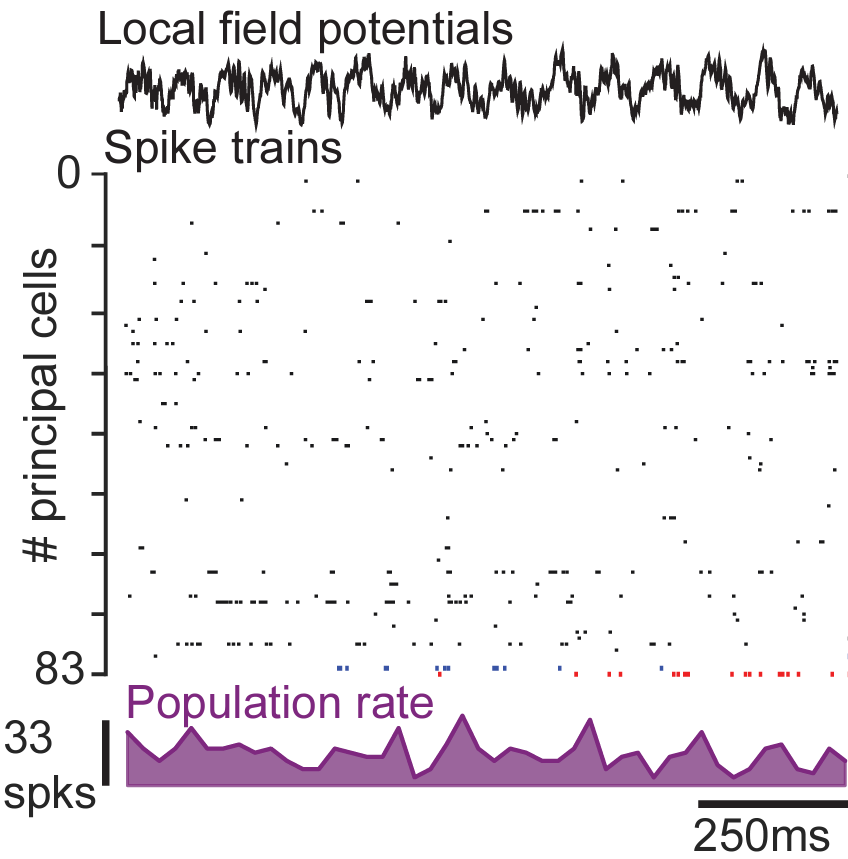Hippocampal ensemble recordings in Contextual Feeding and cNOR tasks from mice
This dataset consists of data to reproduce some of the results in the article 'Organising the coactivity structure of the hippocampus from robust to flexible memory'.
The data is composed of electrophysiological recordings from hippocampus CA1 of 3 mice going through the food-context conditioning paradigm and the cNOR task in both contexts, without any optical manipulation (Figs 1, 2 and 4). Each recording day is stored in a separate folder (e.g. 'mll145-210220').
Inside each folder the data is organised in the following way:
- '.desen': describe the "design of the environment", that is an ordered list of experimental conditions format: '<environment><instance [0, inf]>'
- '.resofs': list with last integer sample of each recorded session (sample freq = 20kHz)
- '.res': list with number of integer samples (starting at 0) at which the peak of a spike is to be found (i.e. ordered list of spike times sampled at 20kHz)
- '.clu': cluster assignment for each of the detected spikes in the .res file. 0. the first line is the total number of clusters in the file. Note that both cluster 0 and cluster 1 are considered noise clusters and not analysed. The rest of the .clu file is the cluster id for each spike in the .res file.
- '.desv': assign a cell type to each cluster id. That is an ordered list of the neuron types of the clusters format: `<type (e.g. p for principal cell)><location (e.g. 1 for CA1)>`
- '.whl': ordered list of locations of the animal
- '.theta.*': files characterising theta cycles recorded from the tetrode closest to the pyramidal layer centre.
- '.desel': describes the ‘design of electrodes', i.e. the anatomical region of the brain that is targeted. Format: '<int> or <string> (e.g. 1 for CA1)'
The 'recordings' folder contains text files that list the recording days for each task. That is 'cond_ll146' and 'cond_ll149' list the food-context conditioning days for the 2 animals, while 'cnor_x' and 'cnor_y' list the cnor days in the two contexts, regardless of the animal identity.
This 'data' folder should be placed inside the analysis folder available for download (default name "orgCoactHippo"), to run the analyses from raw data available in the jupyter notebooks.
We welcome researchers wishing to reuse our data to contact the creators of datasets. If you are unfamiliar with analysing the type of data we are sharing, have questions about the acquisition methodology, need additional help understanding a file format, or are interested in collaborating with us, please get in touch via email. Our current members have email addresses on our main site. The corresponding author of an associated publication, or the first or last creator of the dataset are likely to be able to assist, but in case of uncertainty on who to contact, email Ben Micklem, Research Support Manager at the MRC BNDU.

Creative Commons Attribution-ShareAlike 4.0 International (CC BY-SA 4.0)
This is a human-readable summary of (and not a substitute for) the licence.
You are free to:
Share — copy and redistribute the material in any medium or format
Adapt — remix, transform, and build upon the material for any purpose, even commercially.
This licence is acceptable for Free Cultural Works. The licensor cannot revoke these freedoms as long as you follow the license terms. Under the following terms:
Attribution — You must give appropriate credit, provide a link to the license, and indicate if changes were made. You may do so in any reasonable manner, but not in any way that suggests the licensor endorses you or your use.
ShareAlike — If you remix, transform, or build upon the material, you must distribute your contributions under the same licence as the original.
No additional restrictions — You may not apply legal terms or technological measures that legally restrict others from doing anything the licence permits.

